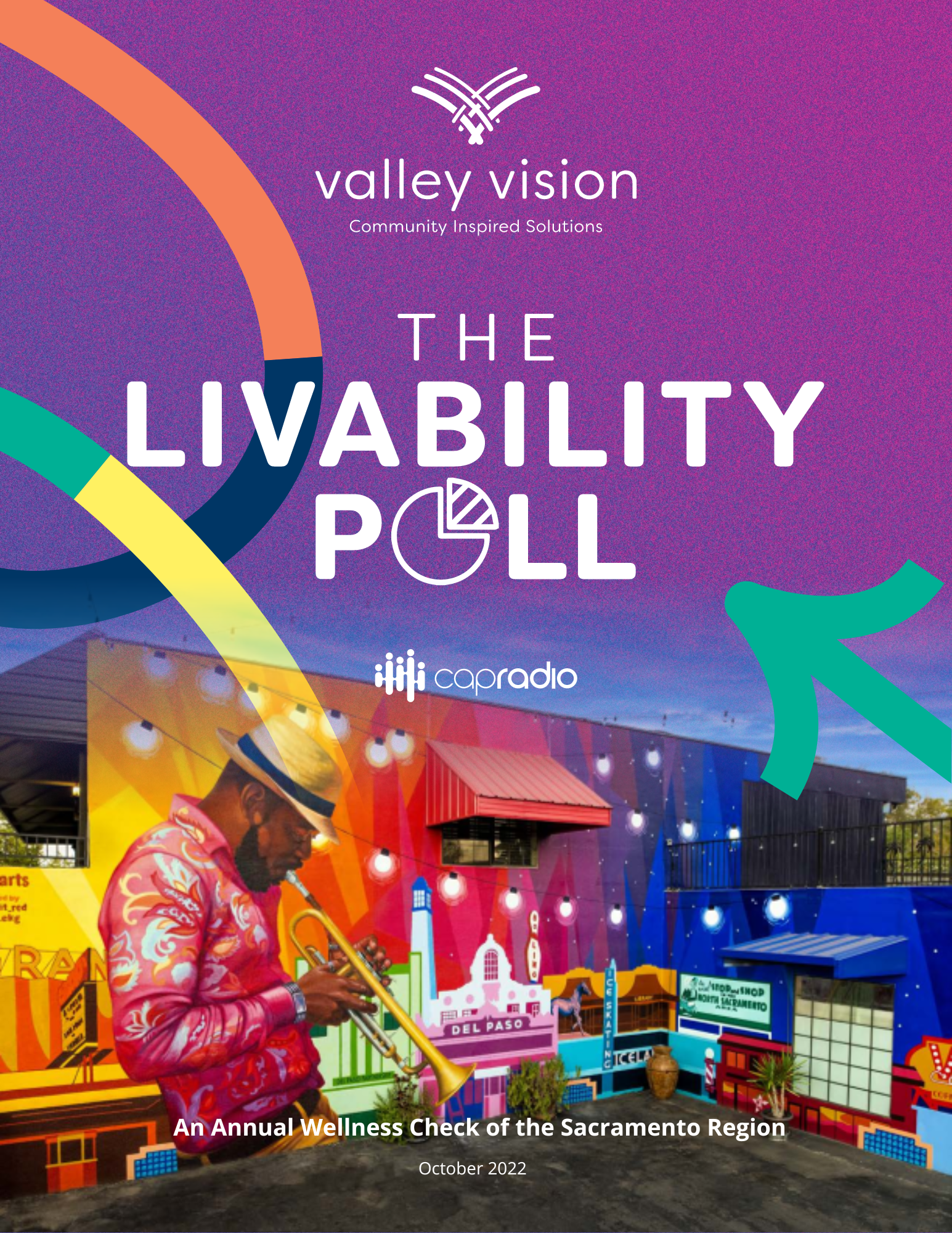The Capital Region’s Workforce—Ready to Evolve
The Livability Poll is a broad-based quality-of-life survey developed by Valley Vision and CapRadio in collaboration with the Institute for Social Research at Sacramento State University. Valley Vision conducted the poll to assess Sacramento residents’ experiences with issues related to housing, access to services, job and career satisfaction, safety and belonging, and residents’ perceptions of the Sacramento Region. Among many topics, the Poll results provide insight into how community residents view their employability.
The Poll was in the field from mid-June to mid-July of 2022. It is demographically representative of the Capital Region, encompassing Sacramento, El Dorado, Placer, Sutter, Yolo, and Yuba counties, and has a margin of error of plus or minus 2.3 percent
Overall satisfaction with employment is high, but a stark contrast can be seen when broken down into categories like race. The most cited reasons for dissatisfaction were low wages; not enough opportunities for promotion; and poor workplace culture. However, feelings of optimism in younger people in the workforce when it comes to employability have risen from previous polls that Valley Vision fielded during the height of the pandemic. As the future of workers continues to change, it was found that more than two-thirds of residents are interested in learning new skills or improving their skills through education and training.
However, the delivery method is key to ensuring residents can access education and training programs. Residents expressed preferences for:
- Programs that last a year or less (72 percent),
- Hybrid (53 percent) or remote (57 percent) programs, and
- Flexible or weekend hours (62 percent)
In order for our region to keep pace with changing industry needs, our communities need flexible and accessible training programs to upskill and increase their economic mobility actively.
While this data confirms the need for equitable career advancement opportunities, the numbers also paint a picture of what is possible. The Capital Region’s workforce is ready to evolve, and our region’s workforce stakeholders have an opportunity to deliver innovative, accessible training solutions to meet their needs. The full 2022 Livability Poll Report can be accessed here.
To keep up with Valley Vision’s work to advance a future-ready workforce in the Sacramento region, subscribe to our 21st Century Workforce email newsletter!
Angelina Olweny is a Valley Vision Project Associate supporting initiatives within the 21st Century Workforce impact area.
Gustavo Garcia is a Valley Vision Project Associate supporting initiatives within the 21st Century Workforce impact area.
Danielle Susa is a Valley Vision Project Associate supporting initiatives within the 21st Century Workforce impact area.
The Livability Summit: Virtuous Circle of Connection
What is Livability?
This is a serious question, not a rhetorical one. We asked this question of community members from all across the region, from different neighborhoods, ages, races, and professions. What we learned is that livability is not the same for everyone.
Responses ranged from housing to safety, good and abundant food to a quality education, and diverse cultural communities to a livable income. Indeed these are all important factors that provide a good quality of life, which proves that livability isn’t just one thing, it’s the combination of many things.
For me, the most poignant and clearest definition of livability that I heard came from a 20-year-old UC Davis student who moderated a youth discussion at Livability Summit on October 4th at Sac State. Tate told the audience of more than 300 that livability isn’t just about having what you need in life, it’s about living a happy life.
Valley Vision’s inaugural Livability Summit was designed to create a data-informed community discussion between diverse networks of people who could exchange views and ideas about the issues that affect us most. The Livability Summit was also about belonging and being heard in a forum where community voices can make a difference. That’s why the Summit tagline “Your voice belongs. Your voice makes change.” was the foundation to community-building and collaborative change-making.



Like others, our region is more disconnected, isolated, and divided than ever before. To counter these challenges and to leverage Valley Vision’s unique purpose of building more livable communities, the Summit proved to be a dynamic day that combined informative and inspirational presentations with small group dialogue, community-building, and interactive experiences.
Coming out of the event and reflecting on the experience, it’s more clear to me that cultivating connection and belonging creates a virtuous loop – you give something positive to others and inevitably you get back something positive that you couldn’t have anticipated. The energy and inspiration that we got back from those who participated was not only inspiring and uplifting but also cemented our desire to continue cultivating these important community connections.
I want to thank the community for coming together with us in a different kind of way, to engage in difficult conversations, and for being willing to bring an open mind and make change that can benefit us all. I am incredibly inspired by the conversations, connections, and collaborations that occurred at the Livability Summit and ready to build off that momentum to leverage Valley Vision’s role in advancing livable communities, especially in those neighborhoods that have long been uninvested and overlooked.
The Summit occured on one day, but the outcomes will carry on through Valley Vision’s work in the months and years ahead. If you were unable to attend this first-time event, I’d like to leave you with a few of the inspirational sentiments that attendees shared with us and hope that you will join us next fall for the first annual Livability Summit. We will announce dates soon.

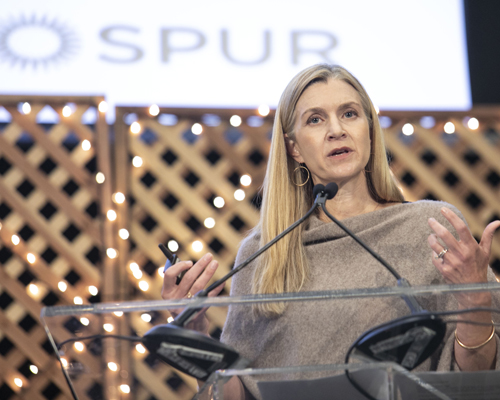
“Keep doing what is right even though it is not easy. ”
“Community connection and belonging are key to livability – keep making it happen.”
“Change happens at the speed of trust!”
“Revitalize and reimagine your community.”
“Youth voices are needed at the table. It’s not enough for them to have a seat at the table – they need to feel they have a voice and the sense of belonging at the table.”
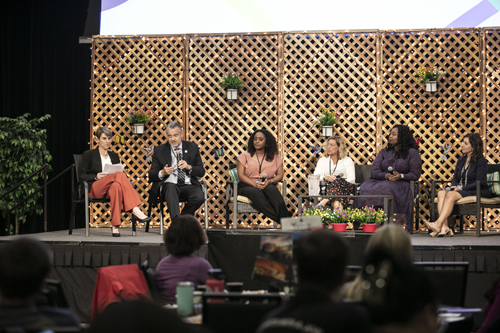

The Livability Summit by Valley Vision
Valley Vision announces a new kind of visioning conversation about the health and well-being of our communities and what we can do together to ensure everyone has access to the quality of life we all deserve.

Valley Vision routinely conducts regional opinion polling to better understand the public’s view on important issues. Differences in where we live, how we live, and our make-up create differing experiences and therefore varying viewpoints on issues like transportation, healthcare, food access and education.
Disparities in experiences are especially evident when talking about quality of life.
The last time we fielded The Livability Poll was in 2018. It was pre-pandemic and the region was on an economic upswing. Things were a lot different then. We believe it is critical to understand how people’s day-to-day experiences may have shifted over the four years since we last surveyed this topic, especially in light of unprecedented hardships that changed so many lives in so many significant ways.
Our most recent Livability poll was fielded in June and it revealed key findings about quality of life for people in our region. For example, in 2018, our findings showed that some residents were feeling left behind and worried about rising housing costs, increasing poverty, and fast-changing neighborhoods. The newest poll showed that cost of housing has grown as the biggest concern for many and also that concerns surrounding mental well-being were notably higher than pre-pandemic times.
For Valley Vision, supporting a high quality of life for all by advancing equity, sustainability and prosperity is our core mission. That is why we will host a regional conversation in the fall that brings community members together to explore ways that we can create unified actions toward improved livability for everyone.
Our full set of research findings will be revealed at the first-ever Livability Summit on October 4th where community members like you can take part in a new kind of conversation. Using Valley Vision’s Livability Poll findings as a wellness check for the region, we will engage in an informed dialogue, imagine ways to improve economic, social, health and wealth in all communities across the region, and seek to define the actions steps we can take collectively as a community to make change.
Addressing the challenging issues we face requires connection to others and a sense of possibility for the future. It is in this environment that we developed the vision for the Livability Summit, an event where “your voice belongs, your voice makes change”. More than just the event slogan, this message reflects our full intention: To create a welcoming place for connection and honest conversation, and a space for the community to come together to take action toward a better tomorrow.
To achieve this, we are focused on a few things:
- Build a program that speaks to important issues in our communities
- Create space for interactive talks with one another about what you are hearing and experiencing
- Offer honest storytelling from real people in real neighborhoods
- Ensure all voices and diverse communities are welcome
I believe that at its best, Valley Vision builds connections across our region. This year’s Livability Summit is our first run at creating an annual event where our community can come together to reflect on how our region is doing across our most important issues, connect with each other in ways we haven’t before, and collaborate on unified actions that move us forward.
The Livability Summit is a community event for everyone.
If you care about improving the health, wellbeing, and equity of our communities, your voice belongs in these important conversations and we hope you join us on October 4th. Register here.

Forestry Management Careers: A Critical Need
On April 28, Valley Vision hosted a virtual Forestry Management Regional Advisory to bring stakeholders and industry partners together to discuss the field’s current state, future projections, and areas of growth. Critical land management challenges such as wildfires, droughts, and the impact of invasive species contribute to the high demand for forestry management job applicants. However, labor market data and research detail a prominent gap between this need and the availability of candidates in the field.

This event featured labor market projections from Melissa Kovacs, Senior Project Analyst at the Center of Economic Development, CSU Chico, and Ebony Benzing, Research Manager at the North/Far North Centers of Excellence, and an industry panel that included:
- Ann Anderson, Beale Mountain Forestry, Owner & Forester
- Jeremy Dorsey, U.S. Forest Service, Hume Lake Ranger District & Sequoia National Forest, District Ranger
- John McCarthy, CAL FIRE, Forester & Wood Products/Bioenergy Program Administrator
- Tony Ortiz, Mountain Enterprises, Field Safety Specialist
- Craig Ostergaard, Sierra Pacific Industries, South Sierra Reforestation Manager
At the beginning of the event, Kovacs presented findings from the 2021 Forest Sector Workforce Needs Survey created in partnership with the Statewide Wildfire and Forest Resiliency Task Force. This survey yielded 113 responses from forestry management employers across the state and sought to identify key challenges and needs within the industry. The research revealed a sizable gap in the forestry industry’s workforce with the majority of respondents indicating their organization is currently hiring for 1-5 open positions with the majority looking to hire either immediately or within the next 12 months. Another important result was the indication of three major obstacles to filling these positions; high cost of living (45.59%), a small pool of candidates in the area (24.56%), and lack of available housing (12.81%).
Benzing provided regional labor market information, demonstrating forestry management jobs are expected to grow by an average of 6% by 2025 in the Greater Sacramento region. The strongest occupational demand is in professional positions which include environmental scientists, soil & plant scientists, and foresters. Management positions are projected to have the highest percentage growth, with the second-largest increase slated to come from specialty positions (fallers, log graders/scalers, surveyors, tree trimmers, and mapping technicians).
Panelists encouraged students and educators to push for early exposure to forestry management careers and real-world, hands-on experience. Paid internships are a valuable way for prospective applicants to gain an understanding of the demands and nature of these jobs. Although these positions are generally during the summer months, panelists indicated winter is the best time to begin the internship and job search process. Anderson of Beale Mountain Forestry mentioned job shadowing as an alternative to internships, as they are a quicker, less-demanding method to show the daily responsibilities and expectations of someone who works in the industry.
Panelists agreed that interpersonal skills are of great importance and demand in the forest industry. Communication, time management, organization, and teamwork are integral skills across all occupations creating an opportunity for forestry management education programs to focus on expanding soft skill development. In addition to strengthening these necessary skills, Steven Casperite, Assistant Principal at the Placer School for Adults, discussed a pilot program developed in partnership with Mountain Enterprises to expand the talent pipeline by offering contextualized English Language education concurrent with on-the-job forestry management training to serve immigrants and refugees. Casperite also commented that the opportunity to extend training opportunities to incarcerated individuals prior to release can also funnel more candidates into the industry. As Casperite said, “There are a lot of opportunities and employees out there that we can be putting to work—that want to work—but we’ve got to remove the barriers.”
Valley Vision’s employer and industry advisories are funded by Los Rios Community College District with Strong Workforce Program funds. Additionally, the Capital Region’s four workforce boards co-sponsor the advisories; SETA/Sacramento Works, Golden Sierra JTA, YoloWorks, and North Central Counties Consortium.
To keep up with Valley Vision’s work to advance a future-ready workforce in the Sacramento region, subscribe to our 21st Century Workforce email newsletter!
Danielle Susa is a Valley Vision Project Associate supporting initiatives within the 21st Century Workforce impact area.
Renee John is the Director of Workforce Development managing initiatives within the 21st Century Workforce impact area.
Leading with Compassion: The Future of Hospitality Careers
On April 22, Valley Vision hosted a virtual regional advisory centered on the adaptations of the Hospitality, Culinary, and Tourism industry through the pandemic. While the sector continues to represent employment below pre-pandemic employment levels, the Greater Sacramento region has recovered 40% of jobs originally lost in this sector. Nationally, wages have increased by almost $3.00 per hour to an average of $19.68.

The event featured keynote speaker Marc Sapoznik, President and CEO of Rancho Cordova Travel & Tourism, labor market information from Aaron Wilcher, Research Director of the Center of Excellence, and an industry panel including:
- Shelly Moranville, General Manager, Residence Inn, Marriott
- Jonathan Modrow, Owner, Bottle & Barlow
- Brittany Claypool, Brand Strategist, Oak Park Brewing
- Andrew Moret, Director of Culinary, Oakmont Management Group
- Marc Sapoznik, President and CEO, Rancho Cordova Travel & Tourism
During the event, panelists described changes and innovations within their companies including moving to fast-casual service with to-go options, producing canned beverages, advancing the adoption of technology, partnering to recruit for talent shortages, and turning a portion of their establishment into community rental space. As Shelly Moranville from Residence Inn, Marriott put it, “We’ve changed the way we do everything.”
“We’ve changed the way we do everything.”
Shelly Moranville
The labor market information presented highlighted a need to fill management positions including General and Operations Managers, Food Service Managers, Personal Service Managers, Entertainment and Recreation Managers, Chefs, and Head Cooks. These positions also offer the highest earnings potential within the industry. The panel agreed on the need for training for management positions highlighting the burnout of their leadership teams from the toll of the pandemic.
Several panelists acknowledged investing more in their current workforce than in the past, including establishing “paths to success” for entry-level employees to gain the skills and experience necessary to prepare them for higher roles. Andrew Moret of Oakmont Management Group discussed their Executive Chef Training Program in development as an example of this upward mobility framework. The panel agreed that learning the career goals of individual team members and helping them achieve them was a best practice. This was just one example of a change to a more employee-centered culture including increased flexibility and accommodation of individual employee needs and schedules. Employers reported altering the availability requirements for existing workers and incoming hires to improve employee retention. As Ms. Moranville stated, “[We] have to be much more flexible to the needs of the associates, and I don’t think that’s a bad thing. As employers, [the pandemic] has forced us to shift and be more understanding of what’s going on in someone’s life.”
The panel agreed the need for high-quality soft skills or essential skills was desperately needed in employment candidates including communication, teamwork, leadership/initiative, cultural and self-awareness, and creativity/adaptability. Jonathan Modrow of Bottle & Barlow stressed the need for an “instinct for care and collaboration”. Mr. Moret closed us with critical words for today’s culture stating the need to lead with “compassion for guests, each other, and yourself” is greatly needed in today’s hospitality workforce.
Valley Vision’s employer and industry advisories are funded by Los Rios Community College District with Strong Workforce Program funds. Additionally, the Capital Region’s four workforce boards co-sponsor the advisories; SETA/Sacramento Works, Golden Sierra JTA, YoloWorks, and North Central Counties Consortium.
To keep up with Valley Vision’s work to advance a future-ready workforce in the Sacramento region, subscribe to our 21st Century Workforce email newsletter!
Danielle Susa is a Valley Vision Project Associate supporting initiatives within the 21st Century Workforce impact area.
Renee John is the Director of Workforce Development managing initiatives within the 21st Century Workforce impact area.
Highlighting Training Needs in Cybersecurity

Valley Vision serves a unique role as the workforce intermediary in the Capital Region’s training and development ecosystem. In this role, we work closely with the community colleges, workforce boards, community-based organizations, employers, industry partners, and local jurisdictions to improve our region’s responsiveness to the needs of both industry and the community. To that end, Valley Vision produces employer and industry advisories in occupational areas of growth and interest to inform education and training partners to address and respond to these needs to support our overall economy.
On March 31st, Valley Vision hosted an advisory on the growing demand for Cybersecurity occupations. The advisory included a keynote presentation by Nathaniel Le of the Federal Bureau of Investigation (FBI) and labor market information including job posting and skills analysis by Ebony Benzing, Research Manager of the Center of Excellence, as well as an industry panel discussion with the following representatives:
- Tania Webb, Managing Director of Deloitte
- Benjamin Troglia, Associate Director of Accenture
- Andrew Maroun, Director of Information Security of Golden 1 Credit Union
- David Bitter, Cybersecurity Manager of SMUD
During the advisory, panelists described a need for both generalists and specialists to meet their staffing needs. While specific technical skills are needed, the highest demand traits these employers revealed were a passion for the work and interpersonal skills, including written and verbal communication, to work well within teams and with external customers. Webb indicated understanding the “why” of the services employees are providing is essential and pre-eminent to thinking through how the technology solution helps meet that need, while Bitter indicated applicants who demonstrate an interest in the field beyond classwork, through clubs or competitions, are highly valued. Additionally, he noted the challenge for educators to keep up with the training needs of the industry due to technology evolving exponentially. He indicated and other panelists agreed, that there is more tendency to recruit generalists who can learn specialties on the job. “I don’t think it’s realistic to expect these students coming out of educational institutions to have that (specific) knowledge,” Bitter said.
While panelists indicated recruiting individuals with a Bachelor’s Degree (or higher) was common, most stated they are open to candidates who can demonstrate the experience, skills, and knowledge without a degree.
Panelists were asked about specific technical skills, degrees, and certifications to obtain entry-level employment in the field. While panelists indicated recruiting individuals with a Bachelor’s Degree (or higher) was common, most stated they are open to candidates who can demonstrate the experience, skills, and knowledge without a degree. Certifications were indicated as one way to differentiate while seeking employment, although practical real-world experience had as high or higher of a value. Specific certifications in demand include SAMs, CISP, and CompTIA Security+, which can elevate one candidate over another and demonstrate the candidate’s initiative to continue learning in their field. Specific technical skills in demand included Linux, Python, and Network Security.
When asked what advice would the panelists give to individuals trying to break into the Cyber Security field, networking, getting as much practical experience as possible, and staying up on the latest news in the security field were indicated as key. Maroun noted a particular challenge is the lack of diverse candidates entering the field which among other challenges limits the group’s creativity diverse backgrounds bring in developing solutions.
Join us for two additional upcoming advisories on the changing needs of Hospitality, Culinary, and Tourism on April 22nd and the expanding needs for Forestry Management Occupations on April 28th. Valley Vision’s full resource industry of advisories is available here.
Valley Vision’s employer and industry advisories are funded by Los Rios Community College District with Strong Workforce Program funds. Additionally, the Capital Region’s four workforce boards co-sponsor the advisories; SETA/Sacramento Works, Golden Sierra JTA, YoloWorks, and North Central Counties Consortium.
To keep up with Valley Vision’s work to advance a future-ready workforce in the Sacramento region, subscribe to our 21st Century Workforce email newsletter!
Nghia Nguyen is a Valley Vision Project Associate supporting initiatives within the 21st Century Workforce impact area.
Renee John is a Valley Vision Project Leader managing initiatives within the 21st Century Workforce impact area.
Yolo County’s YoloWorks! Launches Virtual Employment Center

Job attainment and security are more important than ever, but unpredictable COVID-19 regulations and a turbulent economy have proved it difficult for applicants to access the employment specialists and career services they need. Prior to the pandemic, YoloWorks!, under the Yolo County Health and Human Services Agency, was able to offer in-person career center support and counseling to Yolo County residents from its local offices. However, without a uniform method of providing real-time employment support virtually, the employment center needed to pivot to maintain the full extent of its workforce services.
To address this challenge, YoloWorks! Program Coordinator Erica Johnson developed and aided in the launch of the employment center’s first virtual career center platform. The Virtual Employment Center went live on November 16, enabling Yolo County residents to virtually receive career and vocational training services from employment specialists and case managers.
Making Career Help Available & Accessible
Open 8:00 AM – 4:00 PM Monday through Friday, the Virtual Employment Center (VEC) opens up a myriad of new connections between job seekers and employers. Offering these essential services virtually eliminates a multitude of barriers for new entries to the workforce, including maintaining personal health, reducing travel costs, and more. Training opportunities and the location of available jobs are just two examples of the many services offered by the VEC.
“This is exactly the type of support we want to provide the people of Yolo County.”
Erica Johnson, Yoloworks! Program Coordinator
“Supporting the needs of job seekers with our intelligent chatbot has revolutionized how citizens discover jobs in Yolo County,” said Erica Johnson, YoloWorks! Program Coordinator. “Job seekers can now schedule time with YoloWorks! employment specialists to locate relevant work anytime, anywhere, and have common questions answered quickly in their native language. This is exactly the type of support we want to provide the people of Yolo County.”
Digital Inclusion and the Community
The VEC is a platform that requires internet connectivity to fully utilize. Thus, this calls for adequate infrastructure in the community it serves. YoloWorks! has partnered with Google to provide the “Loan to Own” Chromebook Program for those who might not have access to the devices they need to be successful in this era of virtual integration. Successful completion of this program allows participants to permanently keep their Chromebooks, providing them with a computing device and the ability to earn a work-skills online certificate with digital badging. As of December of 2021, 180 of 250 Chromebooks have been distributed to Yolo County residents. 35 Yolo County residents have completed the program and now own these devices. And to ensure that the platform is accessible to as many communities as possible, Yolo County job seekers can utilize the portal’s chatbox in the region’s three most common languages—English, Spanish and Russian.
This partnership has also granted Yolo County’s YoloWorks! with 500 Google Career Certificates, which are available to Yolo County residents to apply for and receive for free. These certificates include credentials in areas like IT, Project Management, User Experience Design, and Data Analytics. They also provide interested participants with valuable skills such as interviewing tips and connections to 140+ companies that are a part of an employer consortium consisting of nationally-recognized organizations who are hiring for entry-level talent.
From Tragedy Comes Opportunity
With the rise of online outreach and virtual events comes a unique need for collaboration between employers and communities. The VEC constantly works with community partners to ensure that job opportunities are being announced with ample time for applicants to gain access to workstations or smartphones. Additionally, the portal itself promotes ease of access by giving patrons the ability to attach necessary documents (resumes, applications, etc.) and syncing with the account’s Google Calendar. From supplying required technology to providing a user-friendly interface, the VEC is already making waves in terms of reaching the people who would benefit the most from its services.
“The pandemic really shifted the way in which we think, work, and live,” Johnson said. “We wanted to put a service out there for folks that is always available, whether or not they want to come in person.”
To keep up with Valley Vision’s work to advance a future-ready workforce in the Sacramento region, subscribe to our 21st Century Workforce email newsletter!
Danielle Susa is a Valley Vision Project Associate supporting initiatives within the 21st Century Workforce impact area.
Renee John is a Valley Vision Project Leader managing initiatives within the 21st Century Workforce impact area.
What Are You Grateful for in 2021?
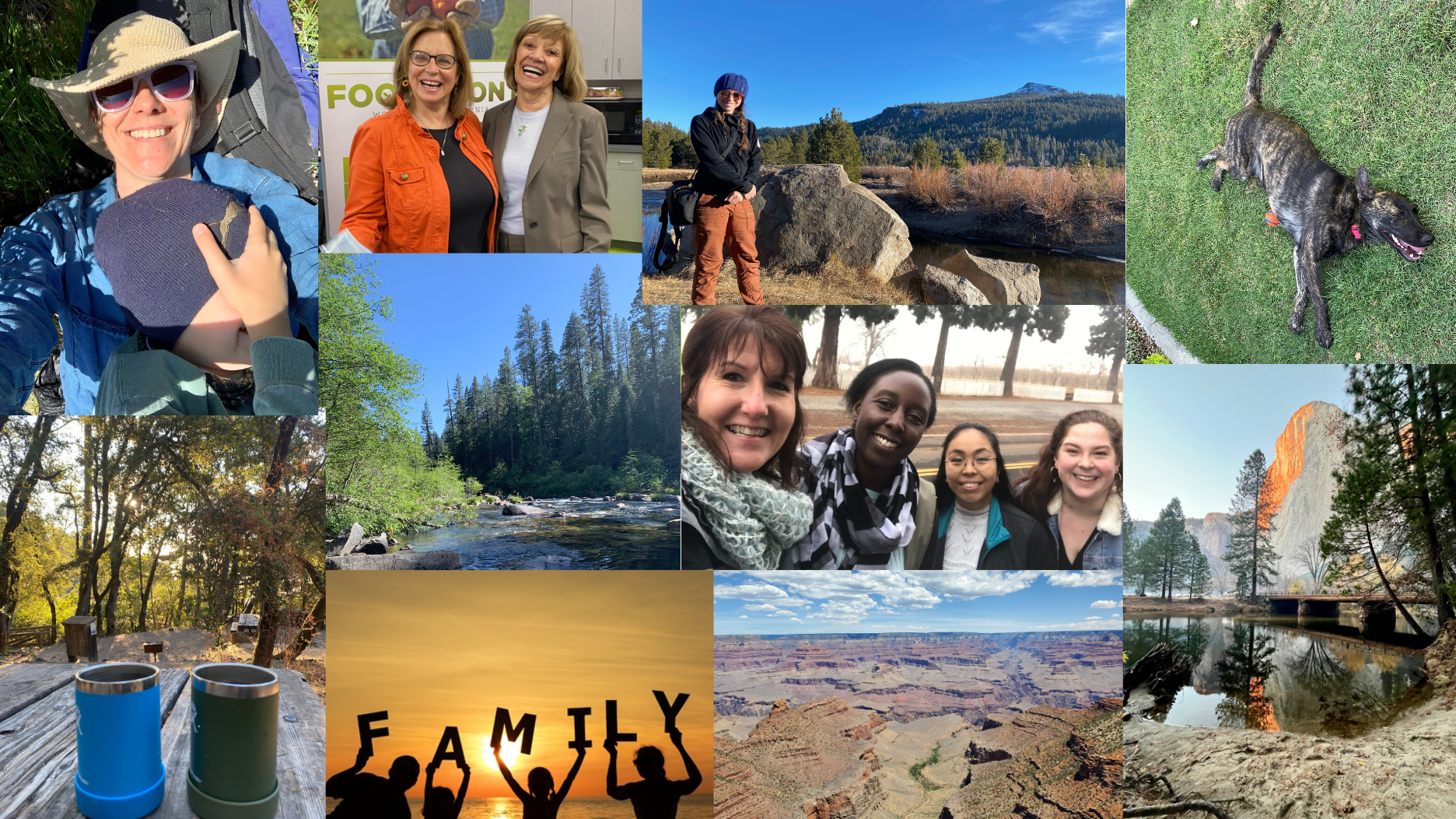
As each year comes to a close, Valley Vision staff reflect on what we have been grateful for over the past year. It’s an annual tradition, and we are excited to share our reflections with you. Thank you for continuing to support and collaborate with us!
Isa Avanceña: “I’m grateful for all the meals shared with family and friends, and time spent outdoors! I’m especially grateful for finally being reunited with my parents after more than two years of not being together! They arrive on Saturday from the Philippines.”
Renee John: “I am grateful for an amazing team dedicated to improving the lives of our region’s residents and for the collaborative efforts of a whole ecosystem of partners striving for a better future for all.”
Alan Lange: “I was grateful to read that charitable giving throughout the nation reached record levels in 2020. I am hopeful that the trend continued through this year. It is heartening to see individuals, businesses, and foundations step up when so many are in need. (And yes, I’m also grateful that the stock market helped buoy the charitable spirit!).”
Brittnii Johnson: “I’m grateful for all the simple things in life that I don’t take the time to appreciate. For example, family, friends that became family, the ability to care for myself, and having a place to live. I’m grateful to experience love in action.”
Grace Kaufman: “I’m grateful for experiences that provide me with a deeper appreciation of life and free me from distractions.”
Angelina Olweny: “I am grateful for good health and the opportunity to be part of a team and organization that is committed to making a positive difference in communities in the Sacramento region.”
Trish Kelly: “I’m very grateful that loved ones have made it safely through the year, that we are able to do work at Valley Vision that contributes to the community, and that the people we work with enrich our lives through rich and caring partnerships.”
Danielle Susa: “I am grateful for the people in my life who remind me why life is precious. I am also grateful for the simpler moments that remind me why life is beautiful.”
Evan Schmidt: “I’m grateful for the health and wellbeing of loved ones over the course of the year, the ability to do work that improves lives and communities, and moments of fun and levity with family and friends.”
Caitlin Blockus: “I am grateful to have adopted my sweet rescue dog in 2021, who has taught me many lessons in patience and understanding, and brought me so much joy and love. I am also grateful for COVID-19 vaccines and the ability to reconnect with my family.”
Natalie Garcia: “I’m grateful to have the opportunity to explore California’s diverse landscapes through van camping. And also grateful to have met some new awesome and authentic friends.”
Adrian Rehn: “I am grateful that myself and my loved ones have their health, and for being able to safely explore much of our country this past Summer.”
The Prosperity Partnership Helps Secure Millions for Inclusive Economic Impact for Greater Sacramento Region
Online webinars to be held starting November 18 for more information on access to funding.
SACRAMENTO, Calif. (November 3, 2021) – The Greater Sacramento region successfully scored two very significant wins via state of California legislative bills that will amount to millions in investment for inclusive economic development including: up to $38 million in funding for Green Means Go; and passage of the $600 million Community Economic Resilience Fund (CERF). Both of these victories were bolstered by the collective advocacy and leadership of The Prosperity Partnership which includes: Greater Sacramento Economic Council, Sacramento Asian Pacific Chamber of Commerce, Sacramento Metropolitan Chamber of Commerce, Sacramento Area Council of Governments (SACOG) and Valley Vision.
“These two victories at the state-level are critical towards the Greater Sacramento region’s recovery and economic resilience, as they not only deliver on real-time investment for jobs, business and infrastructure, but also demonstrate the collective value and impact we have when we work together,” stated The Prosperity Partnership in a joint statement.
Green Means Go is a multi-year pilot that implements the region’s Sustainable Communities Strategy. The pilot aims to lower greenhouse gas emissions and be a catalyst for economic development in the six-county Sacramento region by accelerating infill development. Green Means Go is led and implemented by SACOG, which recently was awarded over $38 million from the state to fund this one-of-a-kind state program. The funds will be critical to accelerate development within existing communities and reduce barriers to building more housing, increasing mobility options and accelerating EV deployment. Outreach and technical assistance will begin in January 2022 for funding requests with all funds to be used by June 30, 2026.
CERF is designed to build a more robust, sustainable, and equitable recovery across all sectors of California’s economy by supporting regional collaboratives in the planning and implementation of inclusive economic strategies towards both recovery and long-term resilience. CERF is funded by a $600 million one-time federal American Rescue Plan Act allocation. Developed in alignment with priorities identified through California Forward’s Roadmap to Shared Prosperity and supported with direct advocacy of The Prosperity Partnership, it will advance pivotal, place-based initiatives and high-road partnerships that reach into under-resourced neighborhoods, regional networks and rural communities; many of which are identified in the core strategies in the work by the partnership through Our Path Forward: The Prosperity Strategy.
An informational session on CERF and funding for organizations and local jurisdictions in Colusa, El Dorado, Placer, Sacramento, Sutter, Yolo and Yuba counties will be held virtually on Thursday, November 18 from 1:00 – 2:00 PM PT. For more information and to register, please visit valleyvision.org to register.
About Our Path Forward and The Prosperity Partnership
Our Path Forward: The Prosperity Strategy is a strategic framework and action plan for the six-county Greater Sacramento region that prioritizes the region’s core economic initiatives for a more prosperous, equitable and resilient economy. The framework was released in May 2020 as both an economic strategy as well as recovery plan. The framework parallels the goals and strategies of the region’s Comprehensive Economic Development Strategy (CEDS) and includes initiatives over the next five years that focus on a cluster-based economy, infrastructure investments and developing a sector-based workforce.
The Prosperity Strategy is the collective work of five regional organizations known as The Prosperity Partnership including Greater Sacramento Economic Council, Sacramento Asian Pacific Chamber of Commerce, Sacramento Metropolitan Chamber of Commerce, Sacramento Area Council of Governments and Valley Vision.
For updates and to learn more visit theprosperitystrategy.org.
Press Contact:
Traci Rockefeller Cusack at 916-213-4373
traci@trockcommunications.com
###
Workers with Disabilities, Untapped Potential

The month of October is designated Disability Employment Awareness Month to recognize the contributions of individuals with disabilities to our workforce and economy. Originally established in 1945, the first week of October was designated as National Employ the Physically Handicapped Week. In 1962, the word “physically” was removed and 25 years later the week was expanded to one month and renamed National Disability Employment Awareness Month. This year’s theme is appropriately named “America’s Recovery: Powered by Inclusion.”
A significant milestone in the fight for disability employment rights occurred on September 27th of this year when Governor Newsom signed Senate Bill 639 into law. This bill prohibits employers from paying employees with disabilities below minimum wage. It also creates a path that transitions workers with disabilities from working in a segregated setting with solely people with disabilities to fully integrated settings. With the signing of this bill, California becomes the seventh state in the nation to outlaw paying workers with disabilities a subminimum wage. The bill sets forth the conditions for a phase-out strategy by January 1, 2025, and requires the involvement and input from people with disabilities.
How Did We Get Here?
In 1939, when President Roosevelt signed the Fair Labor Standards Act (FLSA) into law, there was a fear people with disabilities, particularly returning World War I veterans, would have a disadvantage and experience high rates of unemployment if employers had to pay comparable wages. Therefore, a provision was created to allow workers with disabilities to receive lower wages. Despite the allowance of subminimum wage categories, unemployment rates for people with disabilities have consistently remained disproportionately high compared to the general public. The employment to population ratio for people with disabilities in December 2019 was 30.6, compared to 74.8 for non-disabled people. Additionally, the use of subminimum wage categories has had the unfortunate effect of limiting the potential and advancement of workers with disabilities and resulted in unfair pay compared with their non-disabled peers as reported by the U.S. Department of Labor. Working adults with disabilities are two times more likely to be living in poverty than their non-disabled peers.
WIOA Propelled the Cause
When the Workforce Investment Act was amended in 2016 to the Workforce Innovation and Opportunity Act (WIOA), one of the many provisions was the creation of an Advisory Committee on increasing Competitive Integrated Employment (at least minimum wage and integrated setting) for individuals with disabilities. The work of the Committee was intended to address the pervasive unemployment and low workforce participation among individuals with significant disabilities in the United States. Another backdrop to the Committee’s work was the evolving federal disability employment policy which presumes that all individuals with disabilities are employable when opportunity and support are available.
The Time Has Come
With the signing of Senate Bill 639, Competitive Integrated Employment has the capacity to be a pathway out of poverty for thousands of individuals in our community. By and large, people with disabilities want to work. Changes in work structure, including remote work, have the ability to allow additional opportunities for individuals with disabilities to participate more fully in our economy. Often, accommodations can be the barrier to gainful employment. With the increased opportunity to work from home, many individuals have the opportunity to obtain and maintain employment in an environment equipped and conducive to their health. Many studies document employees with disabilities work harder, are more productive, more loyal, and show a lower absenteeism rate than their non-disabled peers. In the current environment of large-scale job openings and a shortage of workers, casting a wider net can yield immediate benefits.
To keep up with Valley Vision’s work to advance a future-ready workforce in the Sacramento region, subscribe to our 21st Century Workforce email newsletter!
Angelina Olweny is a Valley Vision Project Associate supporting initiatives within the 21st Century Workforce impact area.
Renee John is a Valley Vision Project Leader managing initiatives within the 21st Century Workforce impact area.
Bringing a Region Together Around Housing

California needs more housing. The cost of housing is too high and options available are too limited. These factors are threatening the prosperity of our State. There is little opposition to any of the preceding statements. But friction often emerges as the details of proposed solutions are explored. What type of housing is needed? Where should housing be built? What codes and standards should dictate development? Who should pay the direct and ancillary costs for development? Bringing jurisdictions, developers, residents, and other directly interested stakeholders to consensus on these matters can be grueling. But the payoff has generational impact on the vibrancy of a region.
Stanislaus County initiated the Housing Stanislaus effort to build a common vision for housing in Stanislaus County, and has engaged Valley Vision to facilitate the effort. Valley Vision will work with stakeholders of all backgrounds and interests to establish a shared understanding of the needs, challenges, and opportunities associated with housing in Stanislaus County. That information will be used to build a unified and actionable countywide vision and strategy framework that takes into account priorities, policies, and investments to accelerate affordable and market-rate housing in Stanislaus County.
Valley Vision’s goal is to keep all parties focused on the collective best interest. It will require sacrifices by some, creative solutions by many, and active contribution of ideas and perspectives by all. Valley Vision will be engaging the diverse stakeholders through interviews, listening sessions, surveys, and other forums to collect as much insight as possible, test ideas, and find consensus on what is needed.
All interested parties should keep an eye on the HousingStanislaus.org website (under construction but will be launched soon), or sign up for the Housing Stanislaus email newsletter to track progress and discover opportunities to weigh in.
To keep up with Valley Vision’s work to advance livability in the Sacramento region, subscribe to our Vantage Point email newsletter!
Alan Lange is Valley Vision’s Managing Director, and project lead for Valley Vision’s Healthy Communities Impact Area.
Our Federal Policy “Asks” for a Resilient Food System
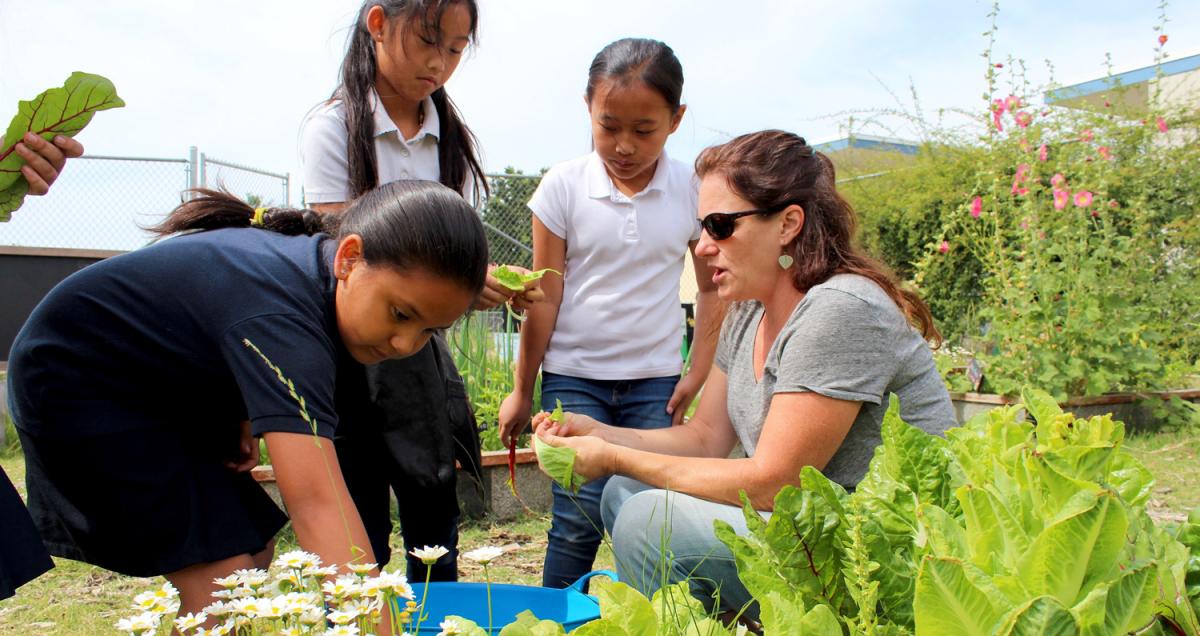
The small but mighty 2021 Food and Ag Cap-to-Cap Team is back prepping for the Metro Chamber’s annual regional advocacy program, which will be held virtually during the last week of October. As America’s Farm-to-Fork Capital, the Team strives to elevate the importance of the $12 billion+ food and agriculture economic cluster, highlighting innovations and initiatives across our food system, and leveraging federal policies, programs and investments.
After the Spring 2020 Cap-to-Cap visit was postponed last year due to the COVID-19 pandemic, the team continued to work with regional, state and federal partners on issues that have even more urgency than before – strengthening the resiliency of the regional food system, and ensuring a strong workforce. Our third big issue – broadband connectivity, access and adoption, which focused on supporting our rural economies and driving adoption of agri-food technologies – has broadened to a high overall regional priority, given all the impacts from the pandemic. We’re grateful to the Cap-to-Cap Economic Development Team for taking on this issue, linking to it as one of the region’s key infrastructure strategies.
To strengthen the region’s resilience, one Cap-to-Cap priority is to target institutional procurement policy changes that will expand local purchasing and supply chains and support local growers, food processors, distributors, and more. We are seeking increased flexibility in the USDA National School Lunch Program’s procurement regulations so local school districts can receive Cash in Lieu of Commodities – meaning school districts can use funds to purchase local goods instead of having to obtain food products from outside the state. This is a true Farm-to-School approach. As we have for many years, we continue to support the development of food system infrastructure such as food hubs, central kitchens at schools, and other facilities and equipment to increase opportunities for farm-to-institution procurement, including for hospitals. We have excellent examples of local procurement initiatives such as with Sacramento City Unified School District’s Nutrition Services and UC Davis Health system that have greatly expanded local purchasing, supporting the local economy and also delivering more than 65,000 fresh and healthy meals daily prepared by our local chefs. We also have a goal to address SNAP eligibility requirements for food insecure college students across the region.
Our other Cap-to-Cap priority is supporting the food and ag cluster’s workforce. Pre-COVID, there was already a skills gap and a pipeline gap across the economic cluster. With the average farmer being 57.5 years of years of age and the average skilled manufacturing (food processing) worker being 55 years of age, we now face a new challenge of worker retention, along with increased demand for digital and agri-tech skills across the entire industry. And of course, we want to ensure that our farmworkers and other front-line workers who kept the regional food system and supply chain going – through health crises and climate challenges, to ensure safe and healthy food for all of us – have safe working conditions and opportunities for income mobility. The Team supports increased federal investments in the Workforce Innovation and Opportunity Act, including for training, industry partnerships, and apprenticeships among others, to reskill, upskill, retain, recruit and grow the next generation of farmers, food entrepreneurs and food system workers. We also support legislation to provides certified agricultural workers with a path to help achieve earned legal status.
The Cap to Cap team is led by Honey Agency, Sacramento City Unified School District Nutrition Services, Valley Vision and Wilson Vineyards. Valley Vision is excited that this year’s program also will benefit from the update of the Food System Action Plan from 2015, prepared in partnership with the Sacramento Region Community Foundation, and the new Food System Resilience Poll, conducted in partnership with Sacramento State Institute for Social Research. These linked reports will be released in early October, giving us new insights for our food system. It will help drive the success of our Greater Sacramento Region Prosperity Strategy, in which food and agriculture is one of our three competitive advantage clusters. We’re also excited that Cap-to-Cap will provide the opportunity to work with our supportive Congressional delegation and new leaders at USDA and other agencies who hail from the region. Please join us to lend your voice and expertise to our food and ag mission!
To continue staying up to date with efforts to strengthen our regional food system, subscribe to Valley Vision’s Food for Thought email newsletter!
Trish Kelly is Valley Vision’s Managing Director, leading its food, agriculture, workforce, and broadband initiatives.
